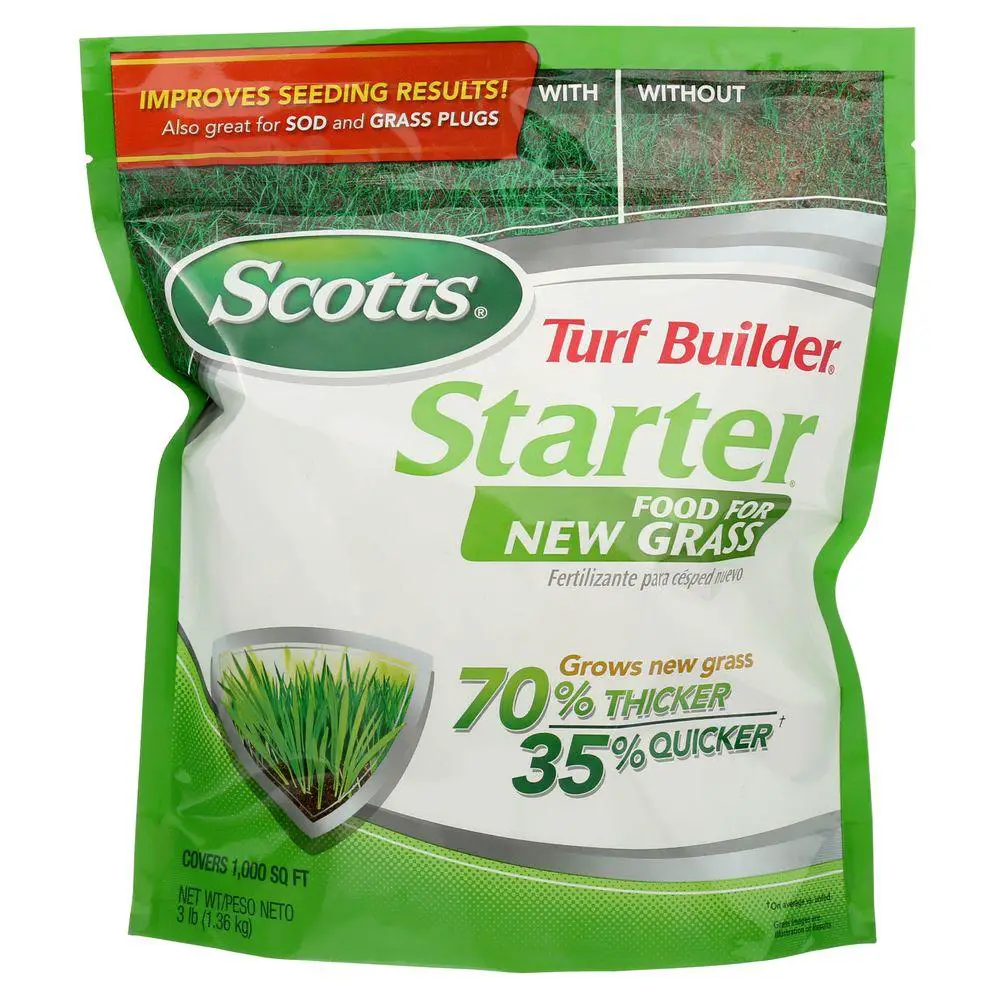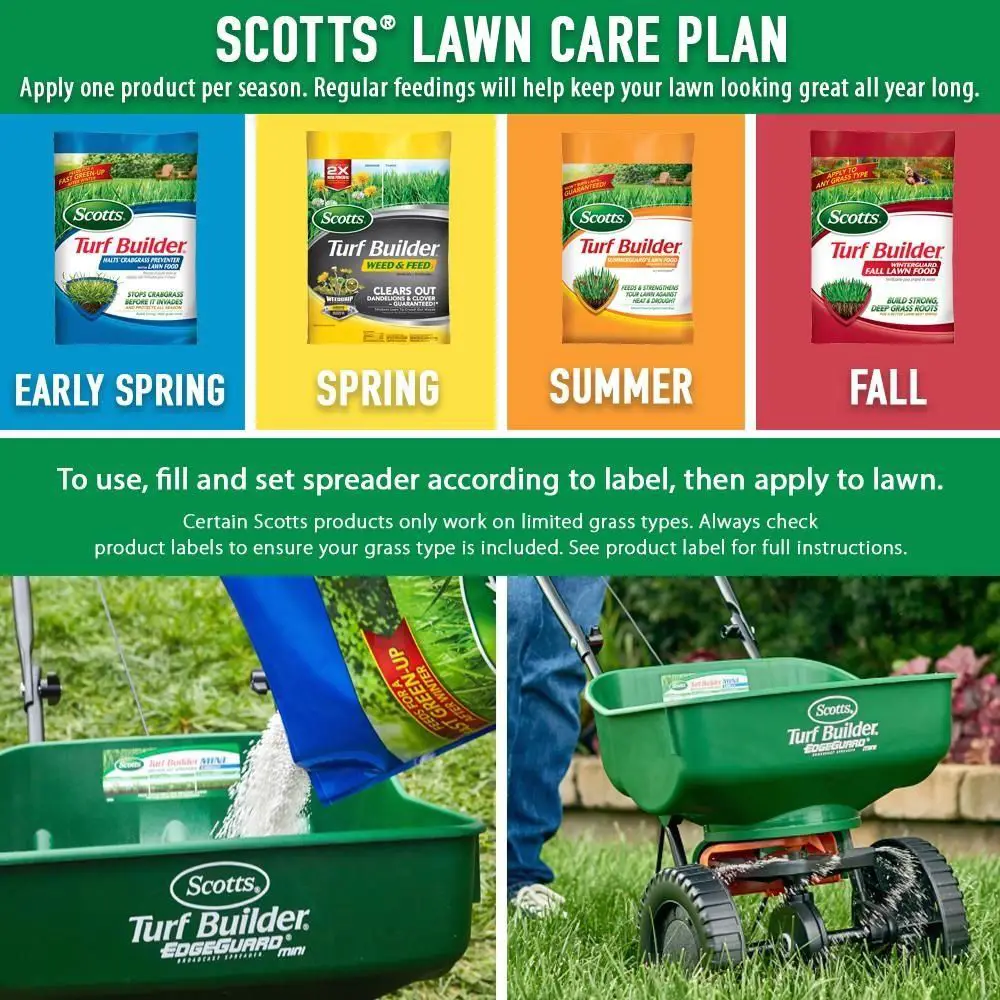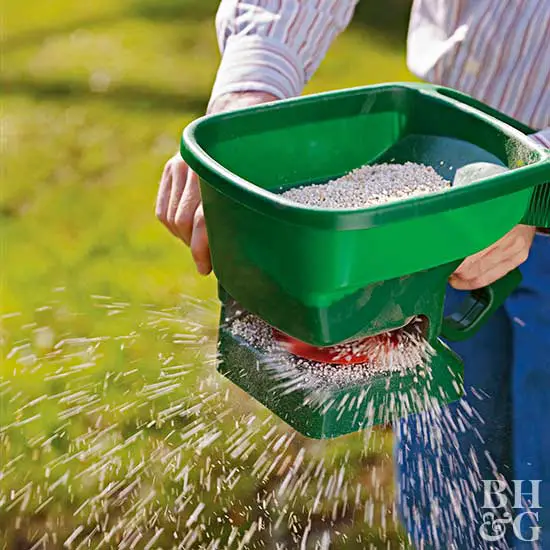Fertilizer For Spring Summer And Fall: What To Apply And When
The proud owners of lush, thick, green grass understand what it takes to get and keep an enviable lawn and fertilizer is their superpower. Knowing all there is to know about how and when to fertilize is their advantage. If you have just had your lawn replaced with thick lush new sod then you want to keep it that way.
Fertilizing your grass isn’t as elementary as sprinkling whatever you have in the shed on your lawn. Fertilizers all present with three numbers that tell us a lot about what’s in the bag. The first number indicates how much nitrogen can be found in a particular fertilizer. The second number represents levels of phosphorus and the third, potassium. Follow this schedule and treat your lawn on a seasonal basis.
Spring
Keep in mind that there are other things you can do before it’s time to fertilize. In late May or early June, before the heat of the summer arrives, apply some slow release nitrogen. This will encourage the grass to rebuild.
A good dose of nitrogen rich fertilizer will also arm your lawn. Fighting off the stresses of summer, traffic, disease, heat, and drought. Fertilizer is its defense. If you can’t stand to sit around and do nothing when the snow melts and the grass that emerges looks like its dead, consider an herbicide. However, herbicides can be harsh on grass, so ensure your herbicide contains a little fertilizer to help your lawn fight the negative effects herbicides can have on grass.
Summer
Fall
There’s A Reason Why November Is The Right Time
Kelly Burke is a professional turf manager for a manicured corporate campus in New England. He is accredited in organic land care and is a licensed pesticide applicator. He formerly managed the turfgrass as a golf course superintendent and has held several senior management positions at private country clubs overseeing high maintenance lawns.
The Spruce
- Working Time: 1 – 2 hrs
- Total Time: 1 – 2 hrs
- Skill Level: Beginner
- Estimated Cost: $50
Keep your lawn or garden healthy before it goes into a period of winter dormancy with an application of fertilizer in the late fall. This is the time when cool-season grasses recover from summer stresses. And turfgrass can begin to store carbohydrate reserves in the stems, rhizomes, and stolons. These carbohydrate reserves help grass resist winter injury and disease, and they serve as an energy source for growth the following spring.
Late-fall fertilization will also provide:
- Better winter color
- Replenished soil in depleted garden beds
Less Grass Fertilizer More Even Distribution
Dial back the rate of lawn fertilizer applications to 1/2, then make two passes with your spreader at right angles.
“I bet at least 3 out of every 5 homeowners use way more lawn fertilizer than they should.”
Many retailers promote a four-step lawn fertilizer schedule for homeowners. Fertilizing more than four times a year is overkill. In fact, most homeowners could get by with two every year. You can cut back on the amount of grass fertilizer you need by knowing when to fertilize lawn based on time of year. More on that later.
If you apply too much lawn fertilizer, especially in sandy soils, a good share of it will leach through the soil and make its way into our precious groundwater, lakes, streams and wetlands. Lawn grasses only need a certain amount of food. More isnt always better.
Unlike us humans, lawn grasses dont know how to stop eating when theyre full! This luxury consumption of nitrogen, phosphorus and potassium actually makes the lawn grasses weak and more susceptible to disease. Excessive grass fertilizer will create too much thatch, which will ultimately choke out your lawn. Too much lawn fertilizer also means youll be mowing far more often than necessary. Too much mowing means excessive soil compaction, exhaust and noise pollution and excessive wear and tear on your mower.
When it comes to a lawn fertilizer schedule, applying more than four times a year is a waste. Save time and money by being more judicious in your use of lawn fertilizer.
Don’t Miss: How Much For Lawn Edging
When To Use Compost
Compost does more than feed grass it also builds and feeds soil. Compost contains microorganisms, micronutrients and organic matter items that nourish soil and foster a healthy underground environment in your lawn. When should you use compost? Spread a thin layer over lawns in early spring to fuel strong growth. Any time you plan to aerate, spread compost after aerating to improve soil and give roots a boost. It’s also a good idea to apply compost before overseeding thin turf. Add compost to a lawn by the shovelful in several places.
When To Fertilize Lawn

Knowing when to fertilize your lawn depends on how often you plan to apply it. If you fertilize once a year, do it around Labor Day thats when lawns absorb the most nutrients. For biannual fertilizing, add a second application the middle of October.
There are exceptions to this timeline depending on climate and soil types, so adjust if your lawn is not retaining enough nutrients. In the spring, if you feel the need, spread a little fertilizer to help the greening process.
Recommended Reading: How To Make Lawn Green Again
How Do I Know If My Lawn Needs Lime
If your grass is yellowing, dying in patches, or grows weakly despite your lawn care efforts, there is a very good chance you need to add lime. Soils become more acidic over time, due to natural nutrients being pulled from the soil by factors such as water runoff and application of certain fertilizers.
When And How To Fertilize Your Lawn
In some ways, lawns are a lot like people. Operating at the peak of beauty and performance requires a good diet and proper care. Lush, thick, green lawns depend on properly timed, properly balanced nutrition to look and grow their best. Understanding when and how to fertilize your lawn can help you and your grass stand out from the rest.
Also Check: How To Get Rid Of Moles In Your Lawn Naturally
Get Professional Lawn Fertilization Assistance
Even though fertilizing your lawn is an important part of regular lawn maintenance, it does take time and know-how to get the job done. Knowing how and when to fertilize yard plants and grass can be a challenge. If youre still wondering when is the best time to fertilize the lawn in spring, or asking can you over fertilize your lawn, it may be time to call in someone who knows the answers!
At The Grounds Guys, our team of lawn maintenance pros can test your soil, recommend the right fertilizer for your type of grass, and apply it for you when the time is right. Learn more about this and the other quality services we offer.
Categories:
Also Check: Quinkill Max Crabgrass And Weed Killer
Does Grass Seed Need To Be Watered Daily
Normally a lawn should be watered deeply but infrequently, but when you are watering for new grass seed, you must water every day. … Twice daily watering is essential until the new grass is up, then after one more week, reduce to once per day. Adjust this pattern according to season and temperature demands.
Read Also: What Kills Wild Violets In Your Lawn
My Tips For Even Coverage
To make sure that you apply your fertilizer evenly, figure out the amount you need based on the square footage of your lawn, then split that fertilizer quantity in half.
Spread half of it in one direction and spread the other half in the opposite pattern . To picture this, imagine the pattern on a checkerboard.
If your lawn is on the larger side, you can use a broadcast spreader that has a side-shield feature. This kind of spreaders side-shield feature means that you will have an easier time applying along the perimeter of the lawn. It will help to make sure that none of the fertilizer gets on sidewalk or driveway .
If you have a small lawn, you might be okay with a drop spreader, though personally I still prefer using a broadcast spreader.
Plan Your Path
When fertilizing your lawn, I always start out by creating a header strip around the lawns perimeter with the side-shield of my broadcast spreader engaged.
Next, work back and forth east to west, then north to south, spreading half of the fertilizer in each direction so you get even distribution across your entire yard.
How Often Is Too Often
The last thing your lawn needs is constant overfeeding. It does nothing to benefit your turf grass, and can be damaging to the environment. For most lawns, applying fertilizer once or twice a year is enough to keep your grass green and healthy. Precisely when you apply fertilizer depends partly on your climate, but mostly on the type of grass you have. The key is to fertilize during the season when your grass is doing the most growing.
You May Like: Rent Aerator Lowes
Also Check: How To Get Dead Grass Out Of Lawn
Should You Fertilize Your Lawn
There are many things to consider before answering this question. Not everyone’s goals and circumstances are the same. So the answer will vary from individual to individual.
If you want a great-looking lawn, and if you have the time, energy, and money to achieve that objective, then the answer is unequivocally yes. Proper fertilization is one factor that can make one lawn in the neighborhood stand out above the rest. Which brings us to the question, How often should you fertilize your lawn? Because, if you truly care about showcasing your lawn, you will want to fertilize it more than someone who is content with a patchy lawn. For the ultimate manicured lawn, you should fertilize it two or three times per year.
But not everyone needs a lush lawn. There are homeowners who value low maintenance over having the showiest lawn on the block. There are some homeowners who are organic gardeners, who shy away from using chemical fertilizers. Homemade compost can be applied to a lawn, instead, but there is work involved in making compost. Gardeners may value what compost is available too highly to waste it on lawns rather than on vegetable gardens. And there are some who simply hold lawns in low esteem for them, grass-covered areas are utilitarian, functioning merely as spaces for walking from point A to point B in the landscape.
Add More Lawn Fertilizer

Feeding your grass in spring with lawn fertilizer provides a boost of nutrients to kick off the growing season. However, your grass requires a few more feedings throughout the year to keep it healthy, strong and looking good. Your grass will make quick work of the lawn fertilizer you give it in early spring, so give it another feeding six to eight weeks after that first feeding.
Because your grass takes a beating during summer thanks to heat, insects, foot traffic and possibly less water, you want to fertilize in June, July or August. To determine a more exact time, plan to add lawn fertilizer between six and eight weeks after your feeding in late spring.
As summer winds down, your grass will start preparing for its dormant season, so adding lawn fertilizer will help it make that transition. Again, wait six to eight weeks from your summer feeding and then apply a fertilizer specifically designed for fall feedings. Talk with your garden center expert to find out what works best for your grass type and location.
Recommended Reading: How To Get Rid Of Violets In Your Lawn
How To Apply Fertilizer To Cool
Don’t fertilize a dry lawn. Instead, wait until the day after a rain, when the soil is moist. It’s also best to time your application so there’s at least a few days before the next rain so your fertilizer doesn’t get washed away before it gets absorbed into the soil. Calculate how much fertilizer you’ll need for your lawn. Use a spreader or broadcaster, walking your lawn in a regular pattern to scatter the fertilizer as evenly as possible.
When And How To Fertilize New Grass
If you’re starting a new lawn from seed, sod or plugs or you’re doing bare lawn spot repair a starter fertilizer helps grass get the perfect start. Unlike established lawns, new grass benefits from extra phosphorus, an essential plant nutrient that supports strong, deep roots. Some states only allow phosphorus-containing lawn fertilizers on new grass, so check with your county extension office if you’re unsure.
On fertilizer products, phosphorus is the middle number in the N-P-K ratio usually “0” in normal lawn fertilizers. But with Pennington UltraGreen Starter Fertilizer 22-23-4, you get an ideal ratio of nitrogen, phosphorus and potassium, plus other essential lawn nutrients, including iron for deep green color. This premium fertilizer blend starts feeding new grass immediately and keeps feeding it for up to three months.
Always follow guidelines for the best time to plant grass seed for your region and grass type, then fertilize accordingly. For seed or plugs, apply fertilizer with a regular lawn spreader before you plant. If you’re starting a lawn with sod, fertilize after your sod is in place.
With any new lawn area, avoid using crabgrass preventer fertilizers or weed & feed fertilizers within four weeks before planting time. After seeding, wait until your new grass gets established and you’ve mowed your lawn at least three times.
Weed & feed fertilizers kill tough weeds and feed your lawn.
Read Also: How Do I Get Rid Of Old Lawn Mowers
Leave The Lawn Cut At The Right Height
Raise the mowing height slightly in the fall. Rooting depth is proportional to mowing height – the longer the leaves, the deeper the roots. Longer grass blades provide some insulation for the crown of the grass plant. However, if the grass is too long going into the winter, it will become matted, which encourages winter diseases such as pink and grey snow mould.
What Month Should I Fertilize My Lawn
Most lawn care companies recommend that you apply lawn fertilizer in the spring, between February and April. This is when your grass will start to green up as it begins to actively grow. Basically, if it looks like your grass is ready for its first mowing of the season, then it should also be ready for lawn fertilizer.
While most people know to fertilize their lawns in the spring, it is important to remember that fall feeding is critical, too. In the fall, grass roots are going down into the soil and need fertilizer to stay healthy. This is the most important application of fertilizer for the whole year since it will protect your lawn as it goes dormant over winter. However, if the fall you should use a specific fall fertilizer that is slightly higher in phosphorous and potassium, as it will promote better root growth. To ensure optimal lawn health, fertilize heavily in the fall and lightly in early spring.
Read Also: Is It Too Late To Dethatch My Lawn
Can I Use A Starter Fertilizer For Grass That Is Established
Probably not. Although you can use a starter fertilizer for a lawn that is established, its better to use a well-balanced fertilizer designed specifically for grass that is established.
Starter fertilizer might not contain all the required nutrients for continued growth and good health. It wont hurt the grass but might lack the needed nutrients that a well-balanced fertilizer for continued lawn maintenance contains.
Feeding The Lawn In The Summer And Fall
Warm-season grasses thrive in the heat of the summer and can be fertilized throughout the growing season. However, cool-season grasses are in a survival mode during the heat of the summer. Refrain from applying fertilizer to a lawn in mid- or late-summer if you live in a climate where cool-season grasses are in your lawn seed mix. A cool-season lawn should need nothing other than water and pest management until September.
Most lawn experts recommend a mild dose of a “turf-builder” fertilizer formulation in the early- to mid-fall, while the turf still has several weeks of active growth before dormancy. This application will help build robust root systems going into winter and restart the growing cycle in the spring. You are not looking to return your lawn to the green of summer. Heading into winter, you can expect a natural slowdown of your lawn’s growth and the loss of its green luster.
Recommended Reading: Does Meijer Sell Lawn Mowers
Should I Put Fertilizer Down Before It Rains
When is the best time to fertilize a lawn before or after a rain? Too much rain could wash away the fertilizer before it has a chance to soak into the soil, so plan to fertilize several days before a heavy rain arrives or several days later. … The result will be a beautiful green, healthy lawn for you and your family.
How Often You Should Apply Fertilizer To Your Lawn

Though fertilizer has its benefits, you dont want to overdo it. A full feeding is recommended at least 5-6 times per year. You want to feed your lawn when its growing most rapidly. However, you should base the frequency on your climate and the type of grass you have. For example, cool season grasses can be fertilized in late spring, but only if necessary.
Warm season grasses, like Bermuda grass, St. Augustine, zoysia, centipede and buffalo grass, should be fertilized in spring. Depending on the amount of water your grass gets, aim to reapply your fertilizer every 6-8 weeks. Keep a watchful eye on your grass. If it looks thick and green, you can probably skip the feeding. If its starting to look brown or black, give your lawn some TLC.
Recommended Reading: How Do Lawn Companies Charge